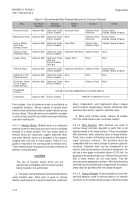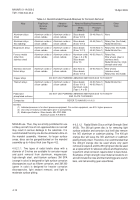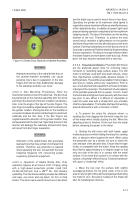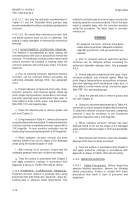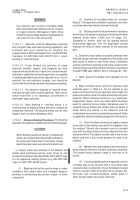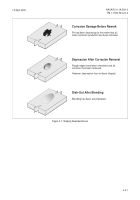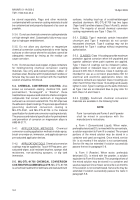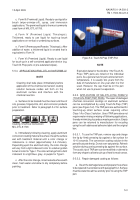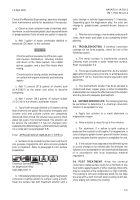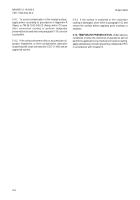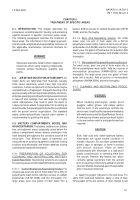TM-1-1500-344-23-2 - Page 96 of 240
4-20
NAVAIR 01-1A-509-2
TM 1-1500-344-23-2
15 April 2009
CAUTION
Refer to the individual aircraft manuals for limits
on metal removal. Do not exceed these limits
without engineering approval.
(4)
In critical areas it is necessary to fair out and
smooth edges of pits to reduce stress concentrations
(see paragraph 4-11). The most effective manner is to
rotate the blast nozzle around the outer edge of the pit,
keeping the nozzle at a constant distance from the work
piece and moving at a constant rate. Several short
passes over the corroded area with the blast nozzle are
more effective than one sustained effort.
e. Upon completion of blasting, inspect for the
presence of corrosion in the blasted area. It may be
necessary to use fluorescent penetrant inspection with
a 10X magnifier. Particular attention shall be given to
areas where pitting has progressed into intergranular
attack. This is necessary because abrasive blasting has
a tendency to close up streaks of intergranular corrosion
rather than remove them if the operator uses an improper
impingement angle. If corrosion has not been removed
in a total blasting time of 60 seconds on any one specific
area, other mechanical methods of removal should be
utilized.
f. Ensure that the limits of metal removal have not
been exceeded, thereby affecting the structural integrity
of the piece.
g. Completely clean all residue from the surface and
exposed areas using a vacuum cleaner or low pressure
air. The vacuum cleaner nozzle shall be plastic or
covered with masking tape to protect surfaces from
mechanical damage. Clean surface using materials
and procedures recommended in Chapter 2. Treat and
protect all blasted areas as soon as possible after
blasting in accordance with the procedures outlined in
Chapter 5.
4-11. SURFACE FINISH
. All depressions resulting from
corrosion removal shall be blended smoothly and evenly
with the surrounding original surfaces. In critical and
highly stressed areas, all pits remaining after removal of
corrosion products, by any method, shall be blended
out to prevent stress risers which may cause stress
corrosion cracking.
4-11.1. PITTING ON A NON-CRITICAL STRUCTURE.
On noncritical structure it is not necessary to blend out
pits remaining after removal of corrosion products since
this results in unnecessary metal removal. Check specific
aircraft manuals for maximum allowable depth of
depressions. The general guidelines for shaping and
blending corrosion grindouts are shown in Figure 4-7.
For additional information, contact ACC/SPM for
blendout procedures.
4-11.2. PITTING ON A CRITICAL STRUCTURE. On
critical structure having a large number of closely spaced
pits, intervening material may be removed to minimize
surface irregularity or waviness. The resulting depression
shall have no sharp corners and shall be saucer-shaped,
wherever clearance permits, with its major axis running
spanwise on wings and horizontal stabilizers,
longitudinally on fuselages, and vertically on vertical
stabilizers (Figure 4-8). In areas where a true saucer
shaped depression cannot be formed due to inadequate
clearance, blend out a depression as nearly as possible
to that shape so that there are no abrupt or sharp edges
(see Figure 4-9).
Back to Top

